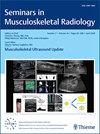肌肉骨骼成像中的错误:如何减少不可避免的错误。
IF 1.1
4区 医学
Q4 RADIOLOGY, NUCLEAR MEDICINE & MEDICAL IMAGING
Seminars in Musculoskeletal Radiology
Pub Date : 2025-10-01
Epub Date: 2025-10-07
DOI:10.1055/s-0045-1810113
引用次数: 0
摘要
大多数错误是由于没有发现病变,或者当发现病变时做出了错误的诊断。临床医生和患者希望得到准确的诊断,这是可以理解的。然而,由于成像的复杂性和固有局限性,准确的诊断并不总是可能的。在致力于提供一个明确的诊断和偶尔出错之间,有一个不可避免的权衡。偶尔犯错比习惯性的不确定更好,也更有用。本文章由计算机程序翻译,如有差异,请以英文原文为准。
Mistakes in Musculoskeletal Imaging: How to Minimize the Inevitable.
Most mistakes relate to either a lesion being missed or when a lesion is seen a wrong diagnosis being made. Clinicians and patients understandably want an accurate diagnosis. An accurate diagnosis, however, is not always possible given the complexities and inherent limitations of imaging. There is an inevitable trade off between committing to trying to provide a definitive diagnosis and occasionally getting it wrong. Better, and more useful, to being occasionally wrong though than habitually noncommittal.
求助全文
通过发布文献求助,成功后即可免费获取论文全文。
去求助
来源期刊
CiteScore
2.50
自引率
7.10%
发文量
112
审稿时长
>12 weeks
期刊介绍:
Seminars in Musculoskeletal Radiology is a review journal that is devoted to musculoskeletal and associated imaging techniques. The journal''s topical issues encompass a broad spectrum of radiological imaging including body MRI imaging, cross sectional radiology, ultrasound and biomechanics. The journal also covers advanced imaging techniques of metabolic bone disease and other areas like the foot and ankle, wrist, spine and other extremities.
The journal''s content is suitable for both the practicing radiologist as well as residents in training.

 求助内容:
求助内容: 应助结果提醒方式:
应助结果提醒方式:


